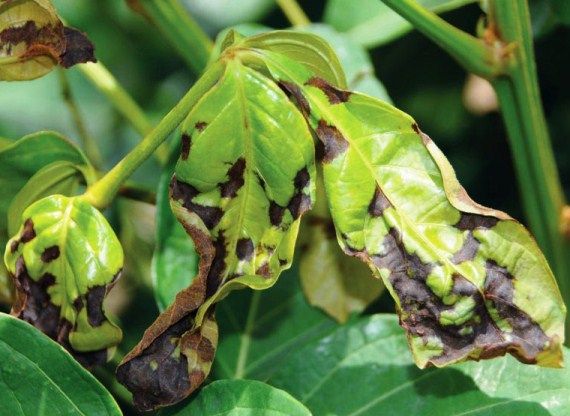Plant Disease and Insects
Today the topic will be about diseases and insects that can have interference in the guarana production.
The main disease for the guarana plants is the anthracnose, caused by the fungus Colletotrichum guaranicola, it is one of the main problems for the low production of guarana in the Amazon. https://www.acritica.com/channels/governo/news/embrapa-lanca-novas-plantas-de-guarana-resistentes-a-doencas-e-de-alta-produtividade-comercial
 Anthracnose
The main insect that attacks the guarana plants is the Liothrips adisi. This species has only been founded in guaraná plants. https://www.embrapa.br/busca-de-publicacoes/-/publicacao/665200/observacoes-sobre-o-tripes-liothrips-adisi-strassen-1977-do-guaranazeiro
Anthracnose
The main insect that attacks the guarana plants is the Liothrips adisi. This species has only been founded in guaraná plants. https://www.embrapa.br/busca-de-publicacoes/-/publicacao/665200/observacoes-sobre-o-tripes-liothrips-adisi-strassen-1977-do-guaranazeiro
 Liothrips adisi
Liothrips adisi
The insects, in order to feed, suck the plant sap, which causes morphophysiological changes in the attacked sites. The leaves, when attacked by these insects, initiate a more rapid evaporation process due to the damages caused, along with exposure to high temperatures in the Amazon. These insects also transmit four different groups of viruses: Llarvirus, Sobemovirus, Carmovirus and Tospovirus. https://www.agrolink.com.br/culturas/problema/tripes_3102.htm
To find a solution to these problems, different strategies and control programs are emerging. To solve the anthracnose disease, Embrapa (Brazilian Agricultural Research Corporation) created genetic improved guaraná plants, the plants are disease-resistant with high commercial productivity. The name of the two new cultivars are: BRS Saterê and BRS Marabitana. The new plants also exclude the use of fungicides to fight against the fungus. https://www.acritica.com/channels/governo/news/embrapa-lanca-novas-plantas-de-guarana-resistentes-a-doencas-e-de-alta-produtividade-comercial The control program for Liothrips adisi needs to be cultural and physical control for the fight against this insect. It is important to know and identify natural enemies and their effect on the insects populations, because with this information is possible to know if increasing the population of natural enemies, cultural methods, use of resistant plants or in extreme cases the rational use of insecticides of low environmental impact can be positive inputs and contribute to the pest control. More studies on this subject need to be done, the reduced knowledge of bio ecology about Liothrips adisi and the monitoring of systems to know the number of instants present in the plantations and detection of outbreaks are important information that need a deeper knowledge for understand the pest and in this way, is possible to have better integrated pest management program.
https://www.infoteca.cnptia.embrapa.br/bitstream/doc/685032/1/Doc69A5.pdf
Today the topic will be about diseases and insects that can have interference in the guarana production.
The main disease for the guarana plants is the anthracnose, caused by the fungus Colletotrichum guaranicola, it is one of the main problems for the low production of guarana in the Amazon. https://www.acritica.com/channels/governo/news/embrapa-lanca-novas-plantas-de-guarana-resistentes-a-doencas-e-de-alta-produtividade-comercial
 Anthracnose
Anthracnose
The main insect that attacks the guarana plants is the Liothrips adisi. This species has only been founded in guaraná plants. https://www.embrapa.br/busca-de-publicacoes/-/publicacao/665200/observacoes-sobre-o-tripes-liothrips-adisi-strassen-1977-do-guaranazeiro
 Liothrips adisi
Liothrips adisi
The insects, in order to feed, suck the plant sap, which causes morphophysiological changes in the attacked sites. The leaves, when attacked by these insects, initiate a more rapid evaporation process due to the damages caused, along with exposure to high temperatures in the Amazon. These insects also transmit four different groups of viruses: Llarvirus, Sobemovirus, Carmovirus and Tospovirus. https://www.agrolink.com.br/culturas/problema/tripes_3102.htm
To find a solution to these problems, different strategies and control programs are emerging. To solve the anthracnose disease, Embrapa (Brazilian Agricultural Research Corporation) created genetic improved guaraná plants, the plants are disease-resistant with high commercial productivity. The name of the two new cultivars are: BRS Saterê and BRS Marabitana. The new plants also exclude the use of fungicides to fight against the fungus. https://www.acritica.com/channels/governo/news/embrapa-lanca-novas-plantas-de-guarana-resistentes-a-doencas-e-de-alta-produtividade-comercial The control program for Liothrips adisi needs to be cultural and physical control for the fight against this insect. It is important to know and identify natural enemies and their effect on the insects populations, because with this information is possible to know if increasing the population of natural enemies, cultural methods, use of resistant plants or in extreme cases the rational use of insecticides of low environmental impact can be positive inputs and contribute to the pest control. More studies on this subject need to be done, the reduced knowledge of bio ecology about Liothrips adisi and the monitoring of systems to know the number of instants present in the plantations and detection of outbreaks are important information that need a deeper knowledge for understand the pest and in this way, is possible to have better integrated pest management program.
https://www.infoteca.cnptia.embrapa.br/bitstream/doc/685032/1/Doc69A5.pdf
Comments
Post a Comment